Parallel-Coupled Microstrip-Lines-Based Miniaturized Balanced Bandpass Filters with Flexible Differential-Fed I/O Ports
Abstract
1. Introduction
2. Working Principles of the Developed Balanced Bandpass Filters
2.1. Analysis with Plane I as the Symmetry Plane
- A. Differential-Mode Analysis
- B. Common-Mode Analysis
2.2. Analysis with Plane II as the Symmetry Plane
- A. Differential-Mode Analysis
- B. Common-Mode Analysis
2.3. Comparison Between Two Different Feed Combinations
2.4. Modified Structure of the Developed Balanced Bandpass Filter
3. Results and Discussions
4. Conclusions
Author Contributions
Funding
Data Availability Statement
Conflicts of Interest
References
- Feng, W.; Che, W.; Xue, Q. New balance—Applications for dual-mode ring resonators in planar balanced circuits (Application Notes). IEEE Microw. Mag. 2019, 20, 15–23. [Google Scholar] [CrossRef]
- Arbelaez-Nieto, A.; Cruz-Perez, E.; Olvera-Cervantes, J.-L.; Corona-Chavez, A.; Lobato-Morales, H. The perfect balance—A design procedure for balanced bandpass filters (Application Notes). IEEE Microw. Mag. 2015, 16, 54–65. [Google Scholar] [CrossRef]
- Feng, W.; Che, W.; Xue, Q. The Proper Balance: Overview of Microstrip Wideband Balance Circuits with Wideband Common Mode Suppression. IEEE Microw. Mag. 2015, 16, 55–68. [Google Scholar] [CrossRef]
- Xue, Y.-C.; Wei, F.; Li, Q.; Ding, X.-Z. Arbitrary-order balanced BPFs and common- and differential-mode quasi-reflectionless BPFs using out-of-phase coupled DSPSL. IEEE Trans. Microw. Theory Tech. 2025, 73, 2879–2891. [Google Scholar] [CrossRef]
- Wei, F.; Zhou, X.-C.; Shi, Z.-H.; Liu, H.-Y.; Qin, P.-Y. A balanced bandpass filter with high-selectivity and common-mode suppression based on inverted microstrip gap waveguide. IEEE Microw. Wirel. Technol. Lett. 2025, 35, 181–184. [Google Scholar] [CrossRef]
- Al-Yasir, Y.I.; Parchin, N.O.; Abdulkhaleq, A.M.; Bakr, M.S.; Abd-Alhameed, R.A. A survey of differential-fed microstrip bandpass filters: Recent techniques and challenges. Sensors 2020, 20, 2356. [Google Scholar] [CrossRef]
- Nie, W.; Pang, Y.B.; Tan, X.H.; Wang, Y.H. Compact wide-stopband balanced bandpass filter with intrinsic common-mode suppression. Int. J. Electron. Commun. 2020, 127, 153456. [Google Scholar] [CrossRef]
- Wang, X.D.; Guo, Z.C.; Huang, F.; Wang, J.P.; Wang, L.L. Design of compact balanced filters with wide DM upper stopband and CM rejection band based on semi-circular patch. Microw. Opt. Technol. Lett. 2024, 66, e34108. [Google Scholar] [CrossRef]
- Romero-Ramirez, M.A.; Olvera-Cervantes, J.L.; Kataria, T.K.; Corona-Chavez, A. Balanced bandpass microstrip filter with high common-mode rejection and extended stopband. Microw. Opt. Technol. Lett. 2023, 65, 1595–1601. [Google Scholar] [CrossRef]
- Medda, A.; Azad, A.R.; Mohan, A.; Sinha, M. Multilayer circular SIW cavity differential bandpass filter with wide-stopband characteristics. Microw. Opt. Technol. Lett. 2024, 66, e34147. [Google Scholar] [CrossRef]
- Li, Q.; Fang, J.; Cao, W.; Sun, J.; Ding, J.; Tie, W.; Wei, F.; Zhai, C.; Wu, J. Optimization and design of balanced BPF based on mixed electric and magnetic couplings. Electronics 2023, 12, 2125. [Google Scholar] [CrossRef]
- Wei, F.; Xue, Y.C.; Zhao, X.B.; Liu, W.; Xu, L.; Zhang, P.F.; Li, R. Balanced BPF with dual-port quasi-reflectionless characteristic and selectivity enhancement. IEEE Trans. Circuits Syst. II Express Briefs 2023, 70, 994–999. [Google Scholar] [CrossRef]
- Wen, P.; Jiang, Y.; Liu, F.; Wang, C.Y.; Ma, Z.W.; Wang, Y.H. Synthesis design of high-selectivity wideband balanced bandpass filter based on parallel coupled lines. Int. J. Electron. Commun. 2024, 176, 155159. [Google Scholar] [CrossRef]
- Ren, B.; Zhao, B.; Guan, X.; Ren, B.; Xu, S. High selectivity balanced bandpass filter using improved parallel-coupled line with intrinsic deep common-mode suppression. Int. J. RF Microw. Comput. Aided Eng. 2022, 32, e34043. [Google Scholar] [CrossRef]
- Fu, S.; Lian, C.X.; Xu, Z.; Wang, Z. Design of highly selective balanced bandpass filter with wide differential-mode stopband and high common-mode suppression. Int. J. Electron. Commun. 2024, 178, 155262. [Google Scholar] [CrossRef]
- Cao, S.; Liu, W.; Guan, X.; Ren, B.; Xu, S. High common-mode rejection balanced bandpass filter using novel coupling scheme and source-loaded coupling technique. Microw. Opt. Technol. Lett. 2024, 66, e34043. [Google Scholar] [CrossRef]
- Xia, Z.; Cheng, R.; Xia, W.; Cao, X.; Xiong, X.; Hu, J. A novel high common-mode suppression balanced bandpass filter with elliptical SIW resonator. Microw. Opt. Technol. Lett. 2024, 66, e70046. [Google Scholar] [CrossRef]
- Li, Z.; Liu, B.; Wei, F.; Xu, L.; Zhang, P.; Li, R. Design of balanced UWB BPF based on quint-mode slotline resonator. Int. J. RF Microw. Comput. Aided Eng. 2022, 32, e23217. [Google Scholar] [CrossRef]
- Feng, W.; Ma, X.; Gomez-Garcia, R.; Shi, Y.; Che, W.; Xue, Q. Multi-functional balanced-to-unbalanced filtering power dividers with extended upper stopband. IEEE Trans. Circuits Syst. II Express Briefs 2019, 66, 1154–1158. [Google Scholar] [CrossRef]
- Wang, X.; Ma, Z.; Xie, T.; Ohira, M.; Chen, C.P.; Lu, G. Synthesis theory of ultra-wideband bandpass transformer and its Wilkinson power divider application with perfect in-band reflection/isolation. IEEE Trans. Microw. Theory Tech. 2019, 67, 3377–3390. [Google Scholar] [CrossRef]
- Bahl, I.J. A designer’s guide to microstrip line. Microwaves 1977, 16, 5 174–182. [Google Scholar]
- Shao, C.; Cai, R.; Zhang, X.; Xu, K. Synthesis and design of a miniaturized broadband bandstop filter with a simple structure. Micromachines 2025, 16, 607. [Google Scholar] [CrossRef] [PubMed]

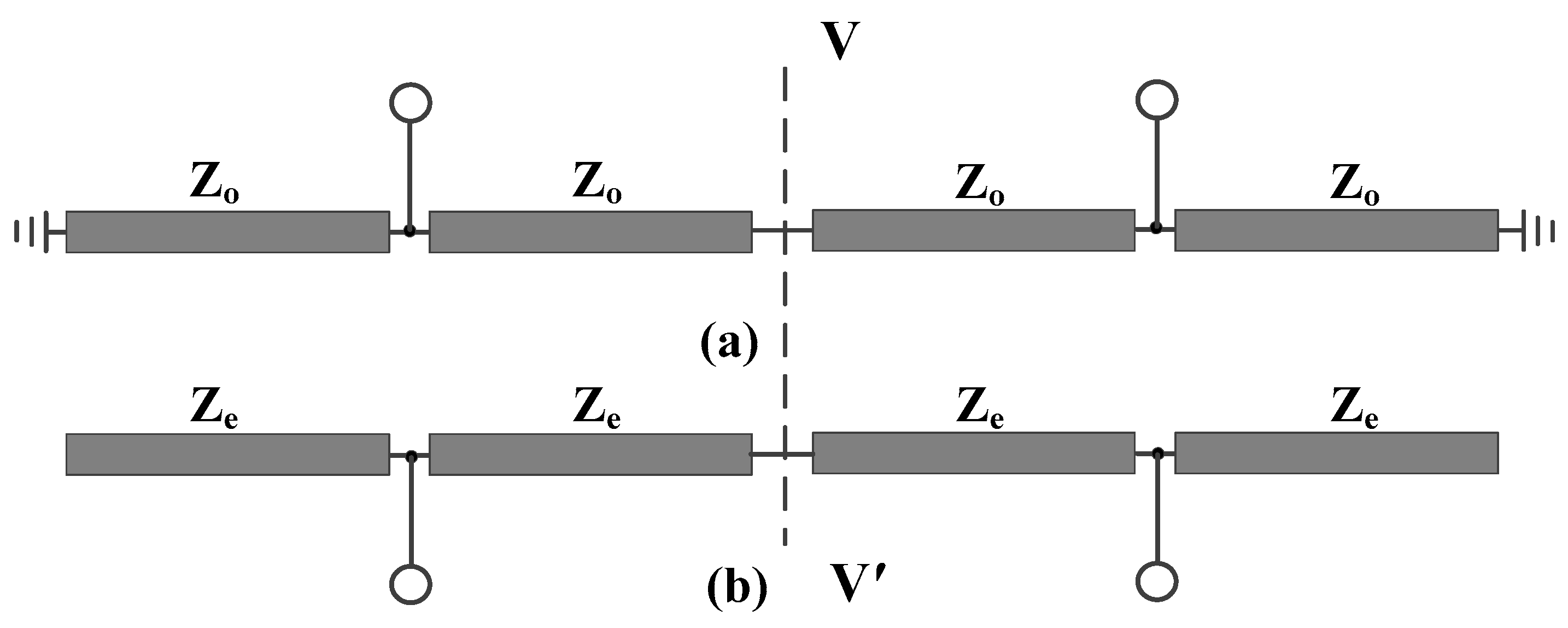
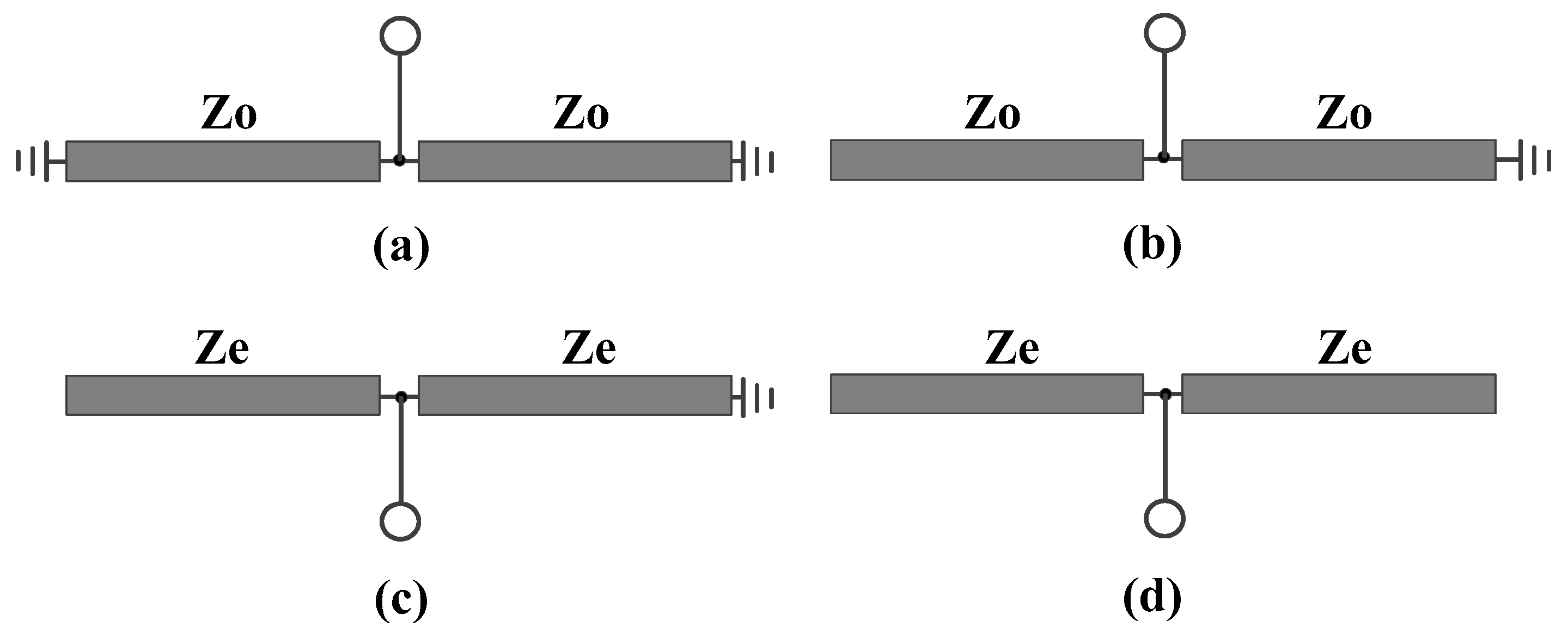
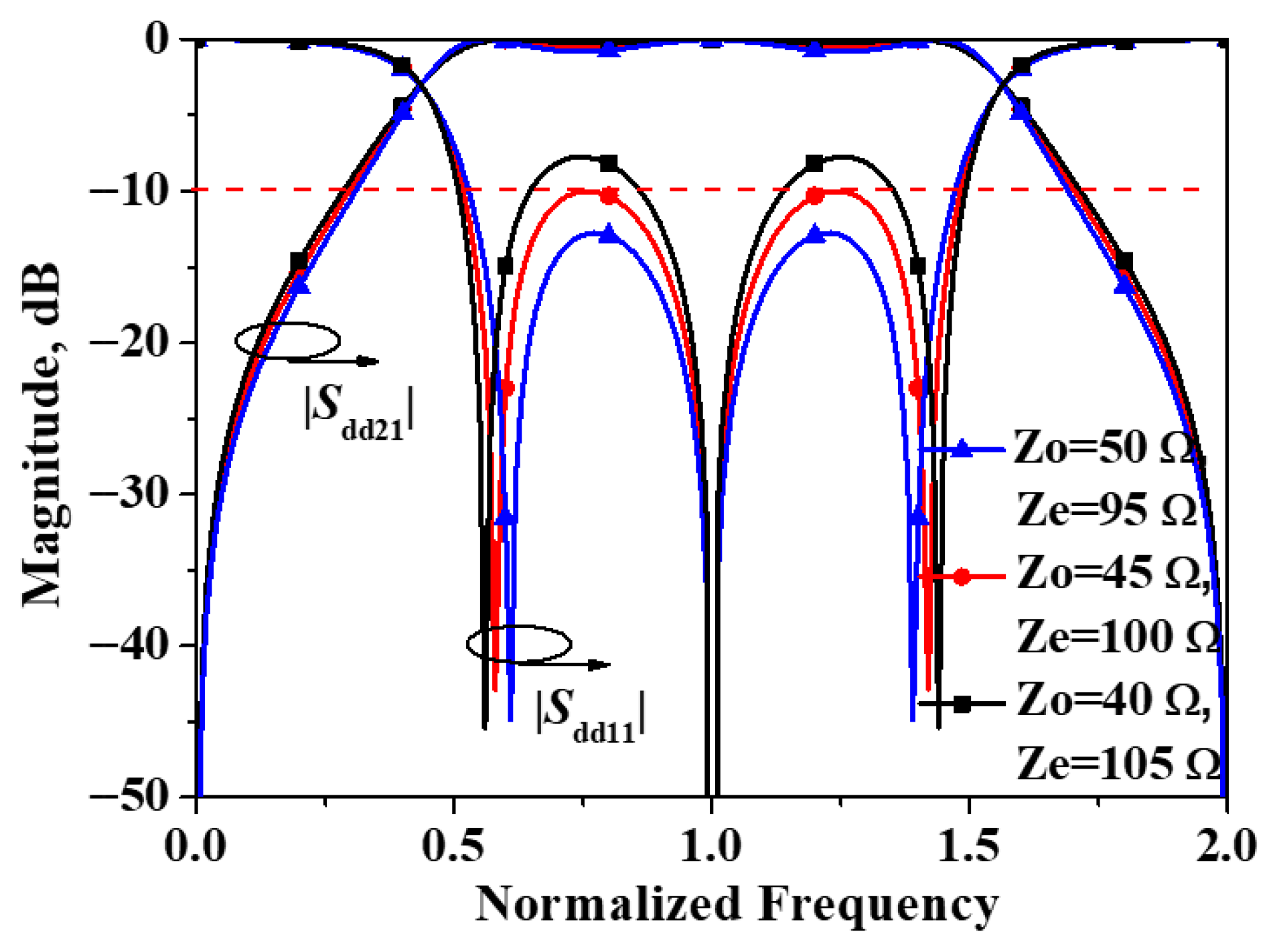
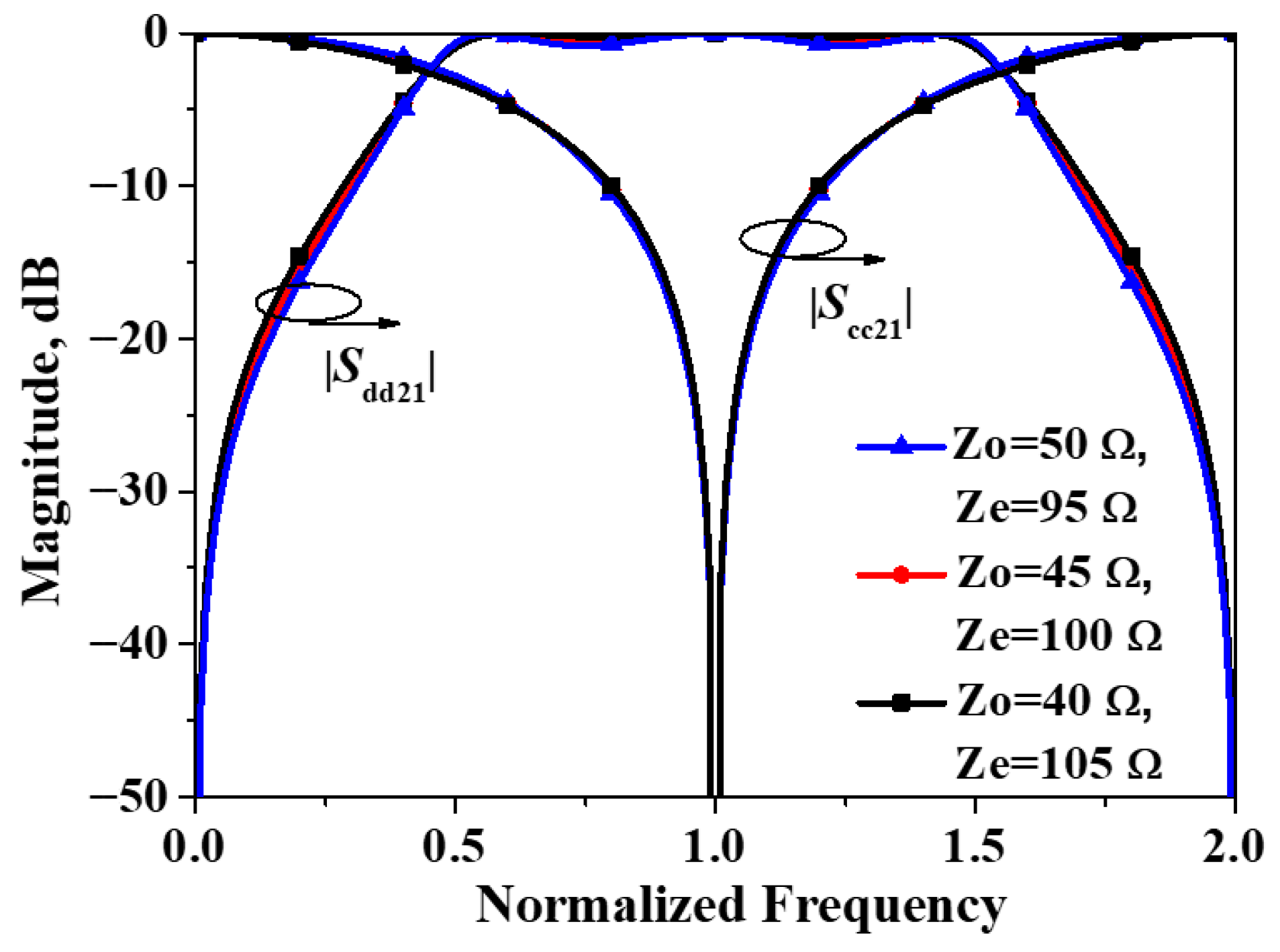

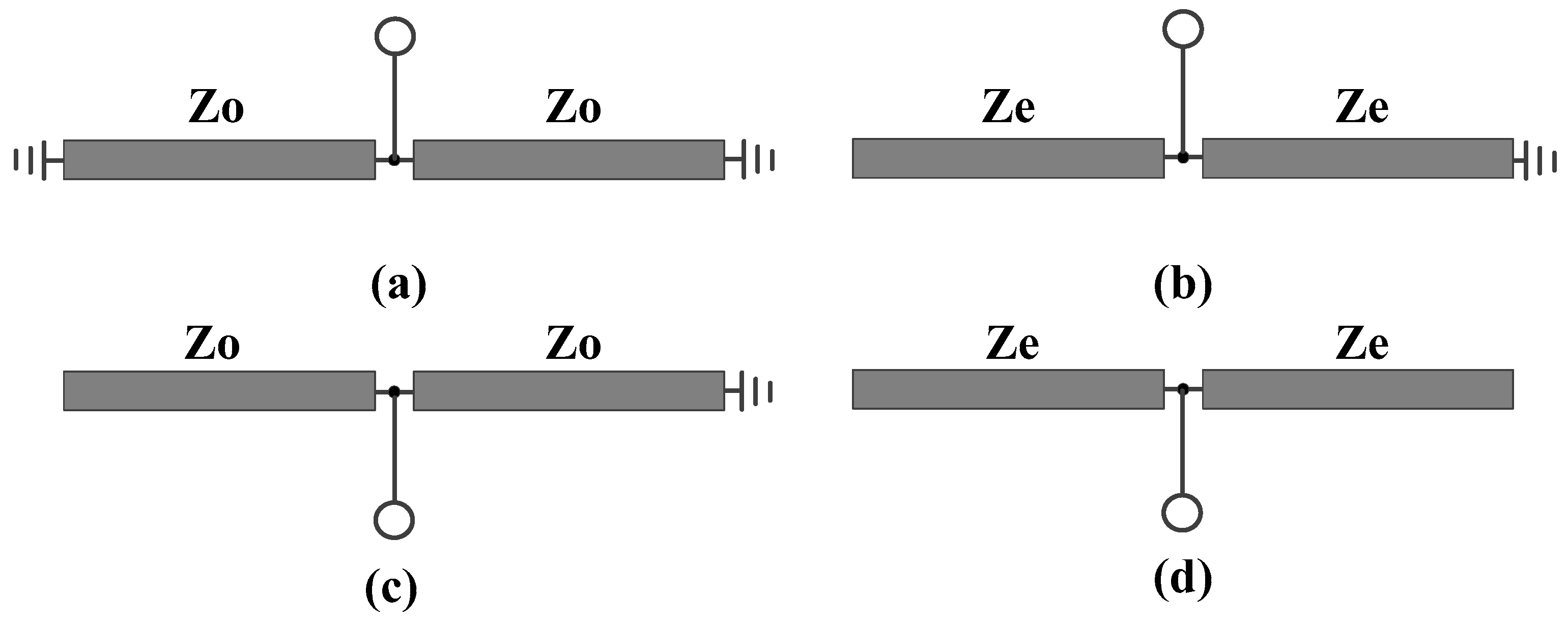
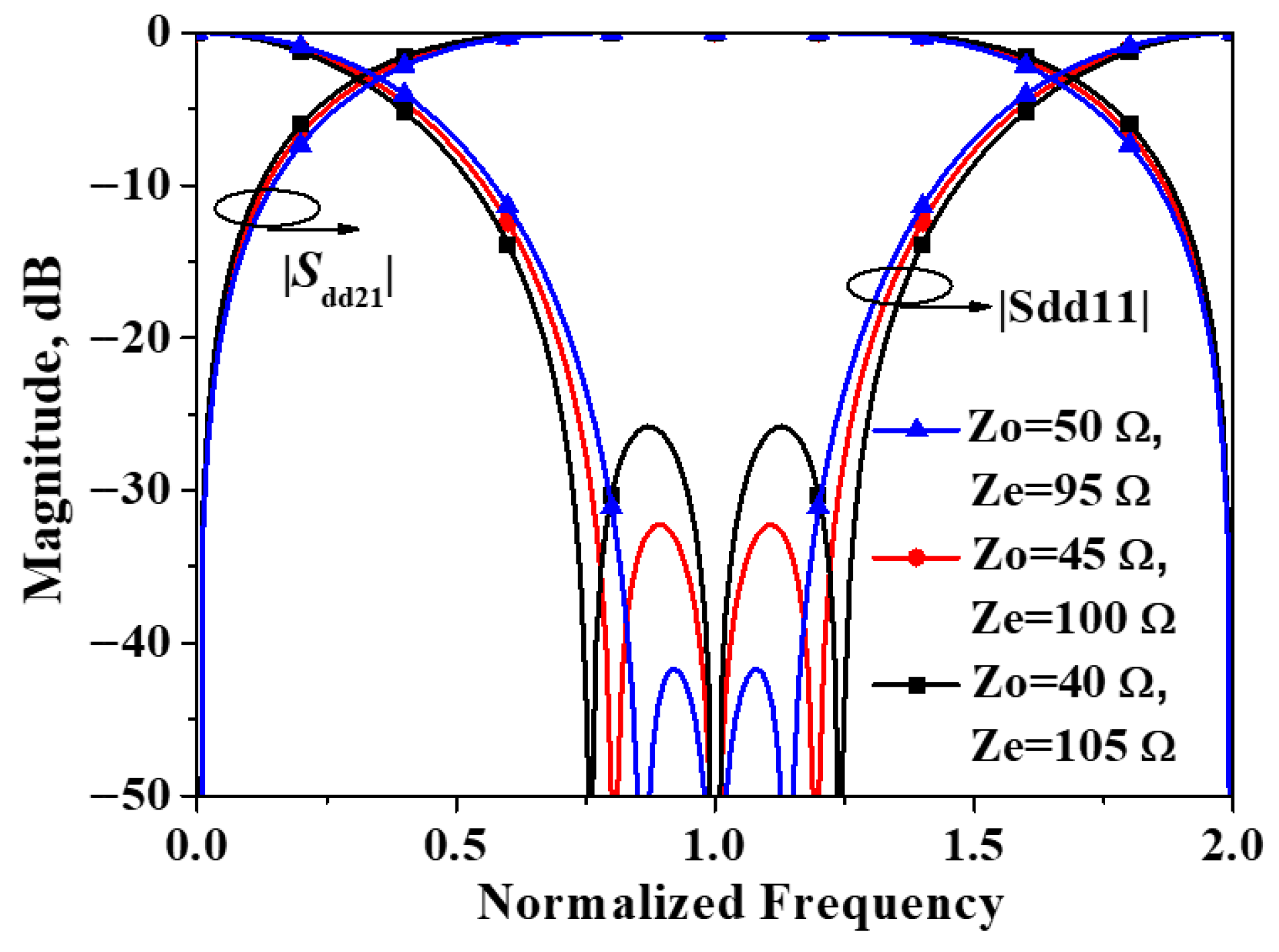
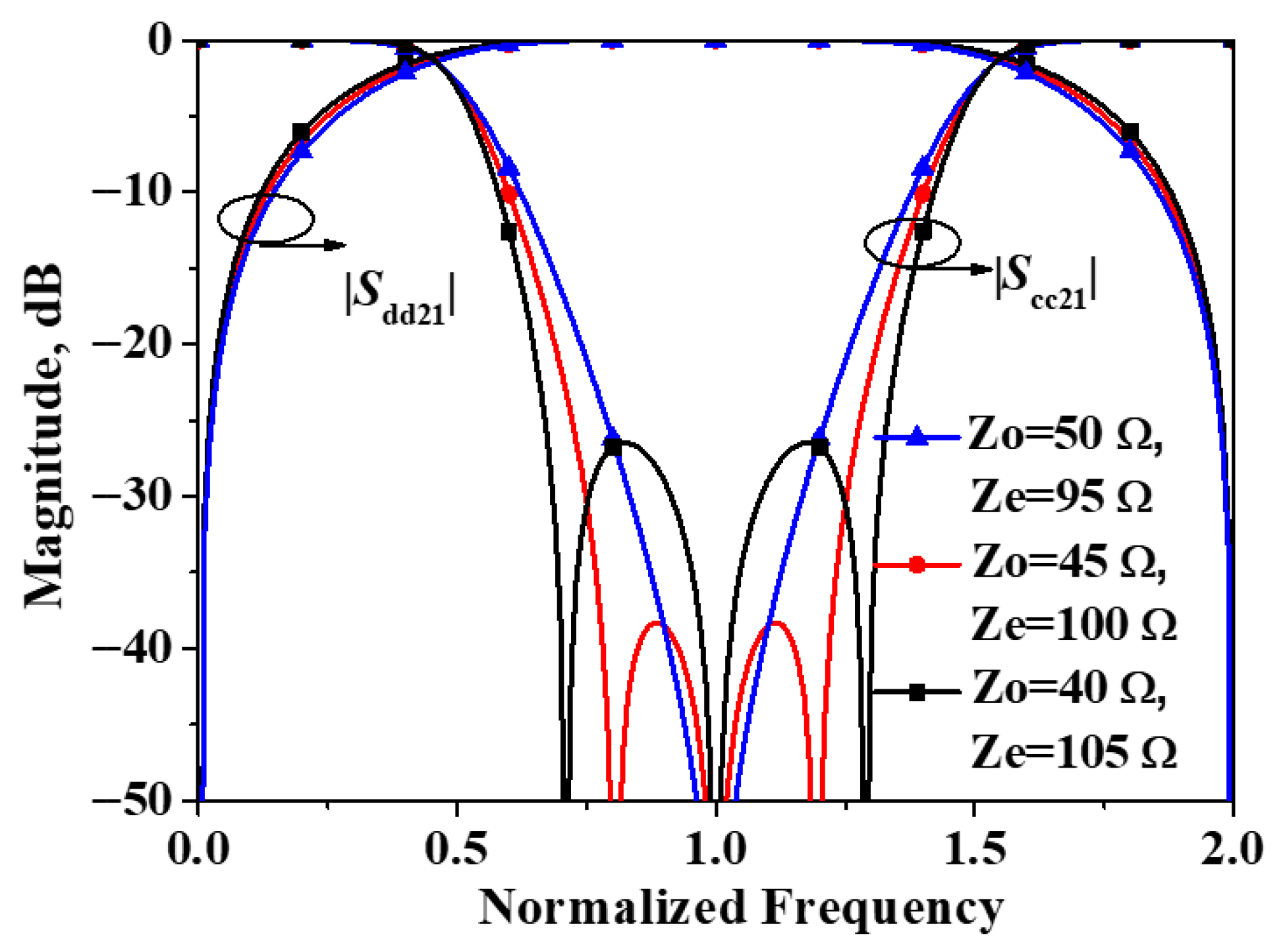




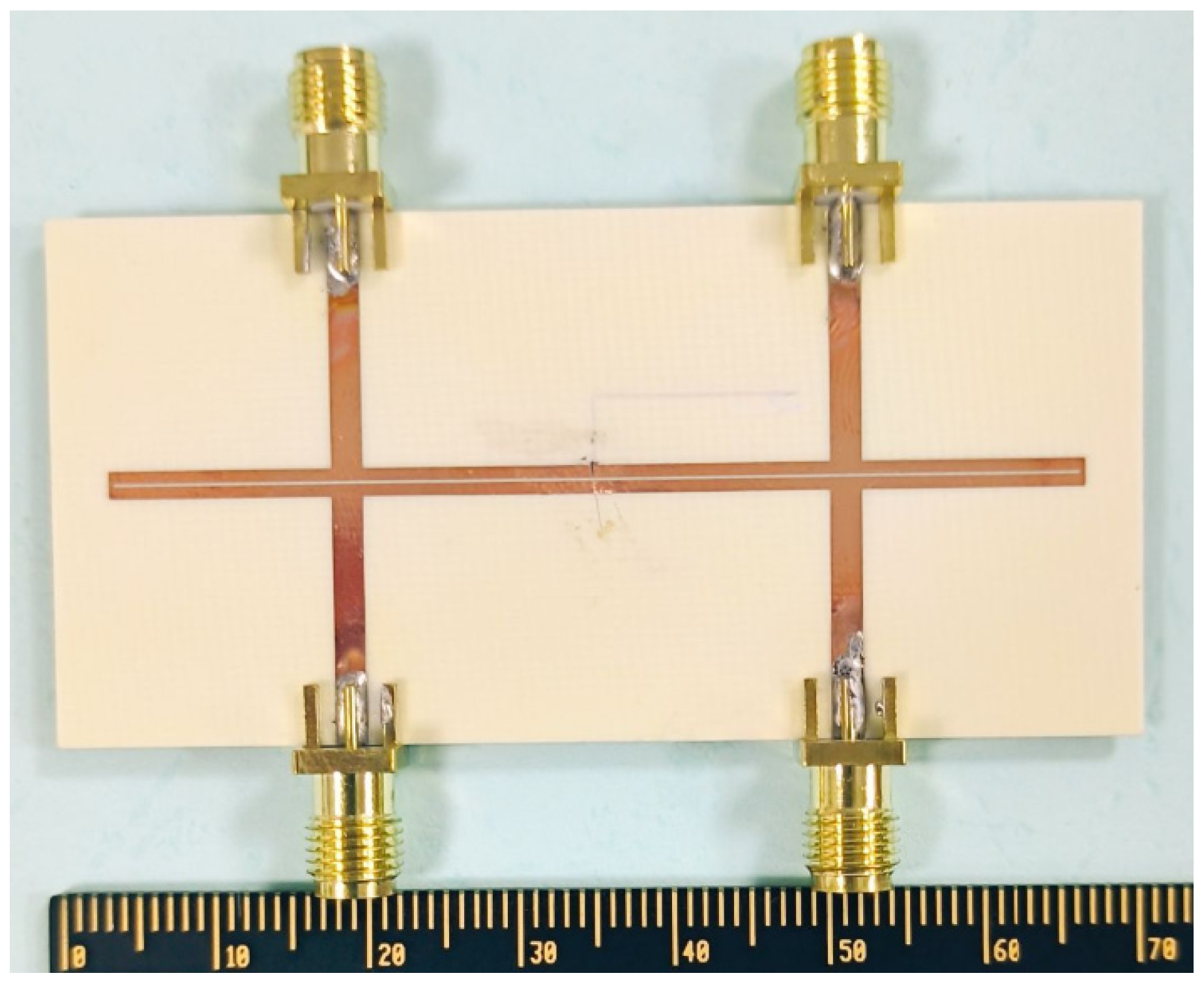

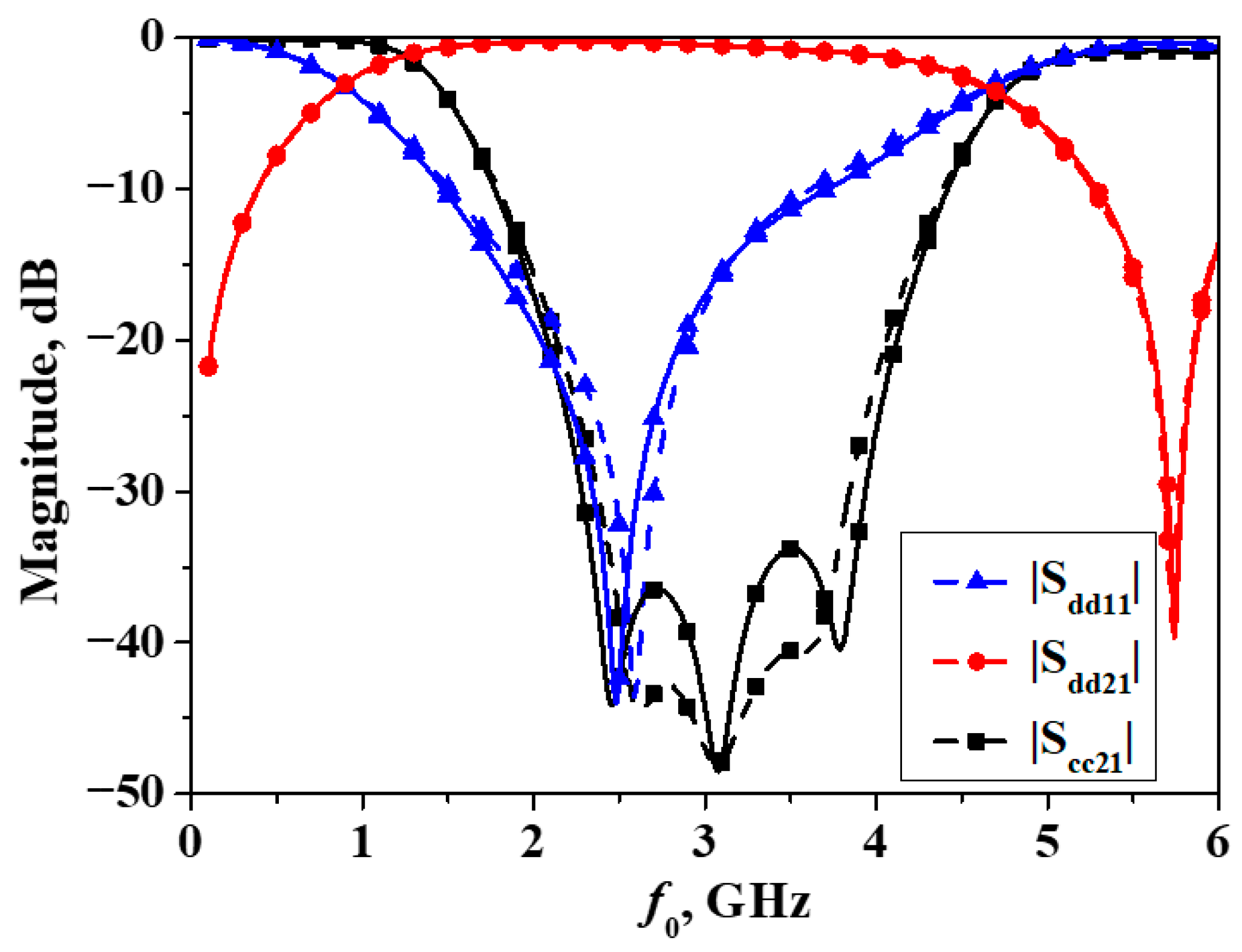

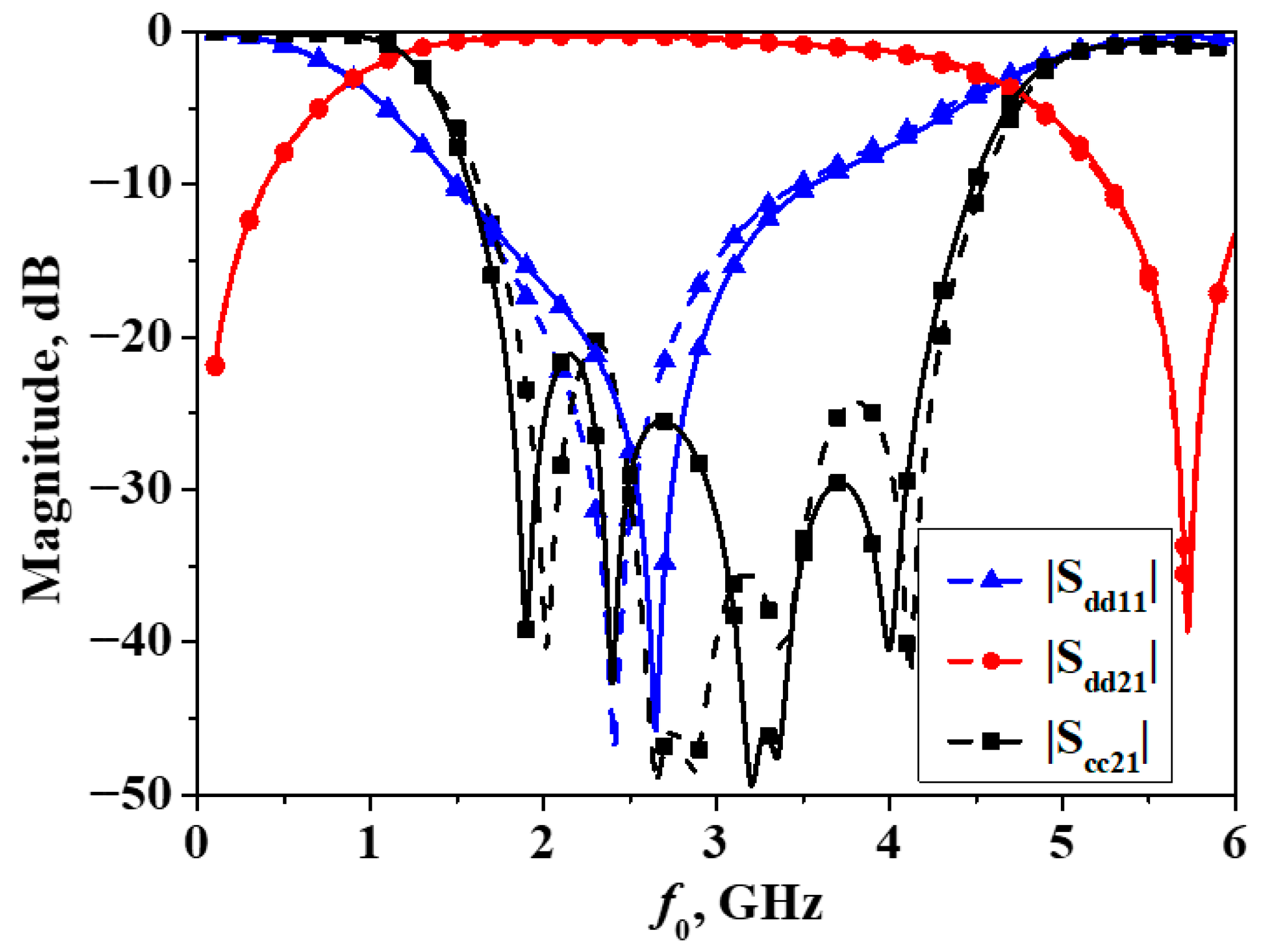
| Reference | f0, GHz/ FBW | Insertion Loss, dB | Layer | CM Suppression Level and Bandwidth | Flexible I/O Ports | Size λg × λg | |
|---|---|---|---|---|---|---|---|
| [7] | 2.4/16% | 1 | Single | 10 dB (DC~10 GHz) | NO | 0.42 × 0.05 | |
| [8] | 2.4/11.3% | 1.2 | Multi | 20 dB (DC~6 GHz) | NO | 0.53 × 0.26 | |
| [9] | 0.92/8.4% | 2 | Single | 40 dB (DC~4 GHz) | NO | NA | |
| [10] | 12/6% | 1.1 | Multi | 20 dB (10~18 GHz) | NO | 1.4 × 1.4 | |
| [11] | 2.47/6.4% | 1.74 | Dual | 40 dB (DC~6 GHz) | NO | 0.49 × 0.24 | |
| [12] | 4.08/34.6% | 1.36 | Dual | 40 dB (1~7 GHz) | NO | NA | |
| [13] | 3.7/92% | 1.23 | Dual | 20 dB (2~5 GHz) | NO | NA | |
| [14] | 2.43/6% | 0.8 | Single | 25 dB (1~3.5 GHz) | NO | 0.54 × 0.33 | |
| [15] | 2.45/16.3% | 1.3 | Dual | 30 dB (DC~10 GHz) | NO | 0.62 × 0.57 | |
| [16] | 2.66/13.8% | 2.9 | Single | 38 dB (1~5 GHz) | NO | 0.49 × 0.34 | |
| [17] | 6.6/116% | NA | Dual | 30 dB (1~12 GHz) | NO | NA | |
| [18] | 3.5/5% | 2.56 | Single | 30 dB (3~4 GHz) | NO | 0.89 × 0.83 | |
| This works | State I | 3/106% | 0.4 | Single | 5 dB (1~4.5 GHz) | YES | 1 × 0.03 |
| State II | 20 dB (2.1~4.06 GHz) | ||||||
| Modified structure | 20 dB (1.76~4.25 GHz) | NO | 1 × 0.1 | ||||
Disclaimer/Publisher’s Note: The statements, opinions and data contained in all publications are solely those of the individual author(s) and contributor(s) and not of MDPI and/or the editor(s). MDPI and/or the editor(s) disclaim responsibility for any injury to people or property resulting from any ideas, methods, instructions or products referred to in the content. |
© 2025 by the authors. Licensee MDPI, Basel, Switzerland. This article is an open access article distributed under the terms and conditions of the Creative Commons Attribution (CC BY) license (https://creativecommons.org/licenses/by/4.0/).
Share and Cite
Shao, C.; Liu, G.; Cai, R.; Jiang, R.; Zhang, X.; Xu, K. Parallel-Coupled Microstrip-Lines-Based Miniaturized Balanced Bandpass Filters with Flexible Differential-Fed I/O Ports. Micromachines 2025, 16, 1238. https://doi.org/10.3390/mi16111238
Shao C, Liu G, Cai R, Jiang R, Zhang X, Xu K. Parallel-Coupled Microstrip-Lines-Based Miniaturized Balanced Bandpass Filters with Flexible Differential-Fed I/O Ports. Micromachines. 2025; 16(11):1238. https://doi.org/10.3390/mi16111238
Chicago/Turabian StyleShao, Chuan, Guijie Liu, Rong Cai, Rongchang Jiang, Xinnai Zhang, and Kai Xu. 2025. "Parallel-Coupled Microstrip-Lines-Based Miniaturized Balanced Bandpass Filters with Flexible Differential-Fed I/O Ports" Micromachines 16, no. 11: 1238. https://doi.org/10.3390/mi16111238
APA StyleShao, C., Liu, G., Cai, R., Jiang, R., Zhang, X., & Xu, K. (2025). Parallel-Coupled Microstrip-Lines-Based Miniaturized Balanced Bandpass Filters with Flexible Differential-Fed I/O Ports. Micromachines, 16(11), 1238. https://doi.org/10.3390/mi16111238







